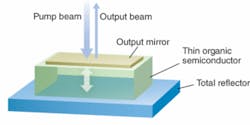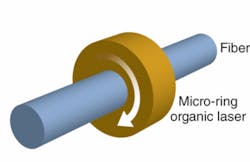Photonic Frontiers: Organic Semiconductor Lasers - The pump is the challenge

Organic semiconductors have opened up new possibilities for optoelectronics as well as electronics. Organic light-emitting diodes (OLEDs) have gained rapid acceptance in portable displays because of their bright emission and low power consumption. They’re common on mobile phones and portable audio players and are scaling upward. Organic semiconductor lasers would seem a logical next step, but where are they?
Optically pumped versions are in the laboratory, where developers have demonstrated a variety of devices and lately have made striking progress in reducing pump powers. At the University of St. Andrews (Fife, Scotland), Ifor Samuel recently pumped a polymer laser with a gallium nitride LED. But electrical pumping of organic semiconductor diode lasers has proved to be extremely difficult.
Organic semiconductors
Light-emitting organic semiconductors fall into two broad categories: small molecules and conjugated polymers. Both types are used in OLED fabrication, but laser developers have focused on conjugated polymers, which can be deposited from solution or printed by ink-jet-like devices.
Organic semiconductors have important attractions that extend beyond the ability to fabricate them in inexpensive arrays for OLED displays. In polymers, the semiconducting properties arise from overlap in electron orbits along carbon chains where single and double bonds alternate. Both emission and absorption bands are inherently wide, and wavelength ranges can be chosen by selecting the compounds that make up the polymer. Like laser dyes, both emission bands and absorption bands are broad, allowing both wavelength tuning and short-pulse generation. The absorption bands are strong and widely separated from fluorescence bands, as required for high gain.
In laser dyes, interactions with neighboring molecules can quench excited states and prevent emission, limiting the usable concentrations of laser dyes in solution. This problem can be overcome in conjugated polymers by adding side groups that separate the excited groups along the molecule from each other.
However, organic semiconductors have other inherent limitations that particularly impact electrical excitation. Electron mobility in them is less than in inorganic semiconductors. Polymers don’t hold up well at the high current densities needed to reach threshold in diode lasers. And another issue is the lack of good transparent electrical contacts to carry current to and from the organic semiconductors. Taken together, these limitations make electrical excitation a far more challenging task than optical pumping.
Optical pumping
The first demonstration of optically pumping a semiconducting polymer came 15 years ago. Daniel Moses of the University of California at Santa Barbara (Santa Barbara, CA) used a frequency-doubled neodymium laser to excite a polymer dissolved in a liquid to form a dilute solution with higher gain than a solid but it was not as convenient as a solid.1
Solid-state versions followed in a few years. Nir Tessler, then at the Cavendish Laboratory (Cambridge, England), optically pumped a 100 nm polymer film sandwiched between a total reflector and a thin-film output mirror confirming that both absorption and gain were extremely high (see Fig 1).2 However, the thin layer of active medium limited the achievable gain, so high pump intensity was needed.
Surface pumping of an edge-emitting Fabry-Perot cavity was also explored. Directing the stimulated emission through a waveguide the length of the polymer film greatly increased the gain length. However, developers found it hard to make good edges in the polymer and the low refractive index of the material limited feedback from the cavity facet. As in edge-emitting diodes, diffraction from the thin emitting layer produced a highly diverging beam. Replacing facet reflection with distributed Bragg reflectors improved feedback into the laser cavity, but did not dramatically reduce the pumping threshold. Optically pumped laser action has also been demonstrated along suitable polymer fibers.A micro-ring laser cavity can be fabricated by depositing a light-emitting polymer along the outside of an optical fiber or inside a capillary tube (see Fig 2). Optical pumping generates stimulated emission in the micro-ring, with low-threshold oscillation in whispering-gallery modes. However, light is emitted around the circumference of the ring, not in a narrow beam, so the output is not laser-like.
Distributed feedback
Distributed-feedback cavities have emerged as an important and more efficient alternative. Gratings with 400 nm spacing are easy to fabricate, and can be embossed in two minutes, Samuel says. Early versions were thin films fabricated with a one-dimensional grating on the bottom, and optically pumped from above. One diffraction order deflects emission along the thin film, where it’s amplified in a larger volume than if the emitted light resonated in a thin vertical cavity. A second order diffracts the emitted light toward the surface, avoiding facet problems (see Fig 3). This design reduces laser threshold, but does not generate a tightly focused beam.More-complex confinement schemes including photonic crystals can improve laser confinement and efficiency and reduce threshold.4 In April, Samuel told the SPIE Europe Photonics Europe conference (Strasbourg, France) that he had improved organic semiconductor lasers enough for optical pumping with a gallium nitride LED (see LED pumps polymer laser, p. 28).
Optically pumped semiconducting polymers also can serve as high-speed optical amplifiers and switches. Earlier this year, Samuel’s group reported attenuating an amplified signal 5.5 dB on a picosecond time scale by illuminating the polymer with a control pulse that matched an excited-state absorption, depleting the gain.5
Electrical pumping
Direct electrical excitation has long been considered the “holy grail” for all types of semiconductor lasers, and organics are no exception. However, the only widely publicized report of electrically pumping an organic semiconductor laser was a fraud perpetrated by J. Hendrik Schön, then at Bell Labs (Murray Hill, NJ), which made it into the pages of Science.6 No one could replicate the work, and eventually Bell Labs recognized the fraud, sacked Schön and retracted his publications.
Although electrical excitation seems easy for organic LEDs, several issues combine to make it a particularly tough problem for organic semiconductor lasers. One is lower electron mobility than in inorganic semiconductors, which limits current flow in organic materials. Although OLEDs can be driven with a current density of just 0.01 A/cm2, organic semiconductors can’t withstand the current densities of 1000 A/cm2 needed to drive an inorganic diode laser. To make matters worse, lasers are far more vulnerable to cavity losses than LEDs, and organic diodes suffer losses from electrical contacts and the depletion of excitons by junction current. “The more charge you throw into the cavity, the more excitons get annihilated, so your quantum efficiency gets worse as you pump it harder,” says Stephen Forrest of the University of Michigan (Ann Arbor, MI).
Nonetheless, Forrest is working on electrical rather than optical pumping. Electrical pumping is “beyond the state of the art,” he says, but he thinks it offers a bigger win than improving optical pumping. He doubts the classic approach of driving high currents through a double-heterostructure cavity will work for organic lasers. Instead, he’s focusing on fundamental research, hoping for a breakthrough.
Outlook
Some key technical issues remain to be overcome, such as improving operating lifetimes of the organic laser materials. But the big question about organic semiconductor lasers is which way the field will go toward perfecting optically pumped versions or toward a new approach to electrical pumping.
Samuel says that optically pumping with an LED is a key advance toward practical devices. “If you have a low-cost package that gives you a versatile laser that has wires hanging off that you connect to a battery, no one will really care that the charges are injected into the nitride and the light comes from the polymer,” he explains. The average user doesn’t care if a green-laser pointer is diode-pumped doubled neodymium or direct-diode laser emission, and optical pumping is much easier to achieve. “I’m hopeful that in five years time, rather than wondering when they finally will get injection lasers, I hope they forget why they wanted injection lasers,” he says.
But Forrest remains unconvinced that optical pumping will ever prove practical. He hopes that with new types of laser cavities, tailored to the nature of the materials, electrical pumping will eventually prove practical. We’ll have to wait and see.
REFERENCES
1. D. Moses, Appl. Phys. Lett. 60, 3215 (1992); DOI:10.1063/1.106743.
2. N. Tessler et al., Nature 382, 695 (Aug. 22, 1996)| doi:10.1038/382695a0.
3. G.A. Turnbull et al., Appl. Phys. Lett. 82, 313 (Jan. 20, 2003).
4. I.D.W. Samuel and G.A. Turnbull, Chem. Rev. 107, 1272 (2007).
5. D. Aramasinghe et al., Appli. Phys. Lett. 92, 083305 (2008).
6. J.H. Schön, et al., Science 289, 599 (July 28, 2000).
About the Author
Jeff Hecht
Contributing Editor
Jeff Hecht is a regular contributing editor to Laser Focus World and has been covering the laser industry for 35 years. A prolific book author, Jeff's published works include “Understanding Fiber Optics,” “Understanding Lasers,” “The Laser Guidebook,” and “Beam Weapons: The Next Arms Race.” He also has written books on the histories of lasers and fiber optics, including “City of Light: The Story of Fiber Optics,” and “Beam: The Race to Make the Laser.” Find out more at jeffhecht.com.



